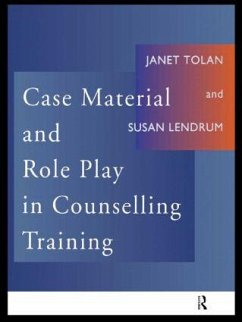- Broschiertes Buch
- Merkliste
- Auf die Merkliste
- Bewerten Bewerten
- Teilen
- Produkt teilen
- Produkterinnerung
- Produkterinnerung
Includes over 250 case vignettes and role plays, step-by-step practical instruction drawn from years of experience and an easy-to-use cross reference system. A much needed resource helping the trainer turn theory into practice.
Andere Kunden interessierten sich auch für
![The Counselling Approach to Careers Guidance The Counselling Approach to Careers Guidance]() Lynda AliThe Counselling Approach to Careers Guidance54,99 €
Lynda AliThe Counselling Approach to Careers Guidance54,99 €![Psychoanalytic Listening Psychoanalytic Listening]() Salman AkhtarPsychoanalytic Listening162,99 €
Salman AkhtarPsychoanalytic Listening162,99 €![Sources of Suffering Sources of Suffering]() Salman AkhtarSources of Suffering51,99 €
Salman AkhtarSources of Suffering51,99 €![Counselling Skills and Studies Counselling Skills and Studies]() Fiona Ballantine DykesCounselling Skills and Studies38,99 €
Fiona Ballantine DykesCounselling Skills and Studies38,99 €![Psychoanalytic Listening Psychoanalytic Listening]() Salman AkhtarPsychoanalytic Listening34,99 €
Salman AkhtarPsychoanalytic Listening34,99 €![The Shadow and the Counsellor The Shadow and the Counsellor]() Steve PageThe Shadow and the Counsellor111,99 €
Steve PageThe Shadow and the Counsellor111,99 €![Reporting in Counselling and Psychotherapy Reporting in Counselling and Psychotherapy]() Linda PapadopoulosReporting in Counselling and Psychotherapy50,99 €
Linda PapadopoulosReporting in Counselling and Psychotherapy50,99 €-
-
-
Includes over 250 case vignettes and role plays, step-by-step practical instruction drawn from years of experience and an easy-to-use cross reference system. A much needed resource helping the trainer turn theory into practice.
Hinweis: Dieser Artikel kann nur an eine deutsche Lieferadresse ausgeliefert werden.
Hinweis: Dieser Artikel kann nur an eine deutsche Lieferadresse ausgeliefert werden.
Produktdetails
- Produktdetails
- Verlag: Taylor & Francis Ltd
- Seitenzahl: 204
- Erscheinungstermin: 25. August 1995
- Englisch
- Abmessung: 246mm x 189mm x 11mm
- Gewicht: 402g
- ISBN-13: 9780415102155
- ISBN-10: 0415102154
- Artikelnr.: 22442537
- Herstellerkennzeichnung
- Libri GmbH
- Europaallee 1
- 36244 Bad Hersfeld
- gpsr@libri.de
- Verlag: Taylor & Francis Ltd
- Seitenzahl: 204
- Erscheinungstermin: 25. August 1995
- Englisch
- Abmessung: 246mm x 189mm x 11mm
- Gewicht: 402g
- ISBN-13: 9780415102155
- ISBN-10: 0415102154
- Artikelnr.: 22442537
- Herstellerkennzeichnung
- Libri GmbH
- Europaallee 1
- 36244 Bad Hersfeld
- gpsr@libri.de
Janet Tolan (Consultant, private practice) (Author) , Susan Lendrum (Author)
PART I USING THE MATERIALS Introduction 1. Why Use Case Materials and Role Play?; Rationale
The importance of empathy
The importance of trainee self awareness
The importance of course members' responsiblity for learning
The importance of the trainer-course member relationship
The importance of equal opportunities
The elements within a training course
Conclusion 2. Case Materials: Purposes and Procedure; Purposes of case materials
Uses of case materials in developing empathy
Procedure for case material 3. Basic Role Play: Purpose and Procedure; Purpose of role play
Projected and personal role play: participant roles
Procedure for basic personal role play
Development of personal role play as training progresses
Procedure for basic projected role play 4. Role Play Variations; Purpose of varying role play methods
Horseshoe
Excuse Me
Rondelle
Demonstration fishbowl
Group and linked role play
Variations on the variations
Conclusion 5. Adapting Case and Role Play Materials; Introduction
Levels of training
Use of key questions for different objectives
Altering the complexity of the material
Adapting for different work contexts
Equal opportunities or difference and discrimination
Conclusion Part II THE RESOURCES How to use Part II Materials Reference Table Section A Core Relationship Skills
Section B Practice Themes
Categories across section A and B Section A Core Relationship Skills Material; A1 Core conditions: the basis for trust
A2 Developing the relationship
A3 Beginnings and endings
A4 Ethics and good practice Section B Practice Themes Material; B1 Loss (general)
B2 Bereavement
B3 Change and transition
B4 Sexuality
B5 Race and culture
B6 Disability
B7 Stress
anxiety
depression
The importance of empathy
The importance of trainee self awareness
The importance of course members' responsiblity for learning
The importance of the trainer-course member relationship
The importance of equal opportunities
The elements within a training course
Conclusion 2. Case Materials: Purposes and Procedure; Purposes of case materials
Uses of case materials in developing empathy
Procedure for case material 3. Basic Role Play: Purpose and Procedure; Purpose of role play
Projected and personal role play: participant roles
Procedure for basic personal role play
Development of personal role play as training progresses
Procedure for basic projected role play 4. Role Play Variations; Purpose of varying role play methods
Horseshoe
Excuse Me
Rondelle
Demonstration fishbowl
Group and linked role play
Variations on the variations
Conclusion 5. Adapting Case and Role Play Materials; Introduction
Levels of training
Use of key questions for different objectives
Altering the complexity of the material
Adapting for different work contexts
Equal opportunities or difference and discrimination
Conclusion Part II THE RESOURCES How to use Part II Materials Reference Table Section A Core Relationship Skills
Section B Practice Themes
Categories across section A and B Section A Core Relationship Skills Material; A1 Core conditions: the basis for trust
A2 Developing the relationship
A3 Beginnings and endings
A4 Ethics and good practice Section B Practice Themes Material; B1 Loss (general)
B2 Bereavement
B3 Change and transition
B4 Sexuality
B5 Race and culture
B6 Disability
B7 Stress
anxiety
depression
PART I USING THE MATERIALS Introduction 1. Why Use Case Materials and Role Play?; Rationale
The importance of empathy
The importance of trainee self awareness
The importance of course members' responsiblity for learning
The importance of the trainer-course member relationship
The importance of equal opportunities
The elements within a training course
Conclusion 2. Case Materials: Purposes and Procedure; Purposes of case materials
Uses of case materials in developing empathy
Procedure for case material 3. Basic Role Play: Purpose and Procedure; Purpose of role play
Projected and personal role play: participant roles
Procedure for basic personal role play
Development of personal role play as training progresses
Procedure for basic projected role play 4. Role Play Variations; Purpose of varying role play methods
Horseshoe
Excuse Me
Rondelle
Demonstration fishbowl
Group and linked role play
Variations on the variations
Conclusion 5. Adapting Case and Role Play Materials; Introduction
Levels of training
Use of key questions for different objectives
Altering the complexity of the material
Adapting for different work contexts
Equal opportunities or difference and discrimination
Conclusion Part II THE RESOURCES How to use Part II Materials Reference Table Section A Core Relationship Skills
Section B Practice Themes
Categories across section A and B Section A Core Relationship Skills Material; A1 Core conditions: the basis for trust
A2 Developing the relationship
A3 Beginnings and endings
A4 Ethics and good practice Section B Practice Themes Material; B1 Loss (general)
B2 Bereavement
B3 Change and transition
B4 Sexuality
B5 Race and culture
B6 Disability
B7 Stress
anxiety
depression
The importance of empathy
The importance of trainee self awareness
The importance of course members' responsiblity for learning
The importance of the trainer-course member relationship
The importance of equal opportunities
The elements within a training course
Conclusion 2. Case Materials: Purposes and Procedure; Purposes of case materials
Uses of case materials in developing empathy
Procedure for case material 3. Basic Role Play: Purpose and Procedure; Purpose of role play
Projected and personal role play: participant roles
Procedure for basic personal role play
Development of personal role play as training progresses
Procedure for basic projected role play 4. Role Play Variations; Purpose of varying role play methods
Horseshoe
Excuse Me
Rondelle
Demonstration fishbowl
Group and linked role play
Variations on the variations
Conclusion 5. Adapting Case and Role Play Materials; Introduction
Levels of training
Use of key questions for different objectives
Altering the complexity of the material
Adapting for different work contexts
Equal opportunities or difference and discrimination
Conclusion Part II THE RESOURCES How to use Part II Materials Reference Table Section A Core Relationship Skills
Section B Practice Themes
Categories across section A and B Section A Core Relationship Skills Material; A1 Core conditions: the basis for trust
A2 Developing the relationship
A3 Beginnings and endings
A4 Ethics and good practice Section B Practice Themes Material; B1 Loss (general)
B2 Bereavement
B3 Change and transition
B4 Sexuality
B5 Race and culture
B6 Disability
B7 Stress
anxiety
depression








